News
A multifunctional clothing for human thermal management that can absorb moisture, cool, stain, and resist bacteria in high temperature environments
In recent years, due to the continuous deterioration of the environment, extreme weather events have become increasingly frequent (such as global extreme heat weather), which poses a huge challenge to human normal life, especially for people working in special environments. Therefore, personal protective equipment (PPE) plays an indispensable role in protecting personnel such as firefighters, soldiers, and medical staff working in harsh environments. Personal protective equipment can prevent viruses (such as COVID-19), fires, and physical and chemical injuries. PPE can effectively reduce the risk of injury in harsh environments, but at the same time, it can also cause a decrease in human moisture permeability, severely limiting the evaporation of sweat and the heat dissipation of the human body. Due to the excessive sweating of personnel wearing PPE during work, sweat tends to accumulate on the skin surface inside the PPE, making it difficult to evaporate and increasing heat stress and discomfort. When working in a high-temperature environment for a long time, it can ultimately lead to bacterial growth, muscle spasms, electrolyte imbalances, heatstroke, and even death.
Having a comfortable thermal environment is not only an essential requirement for normal human life, but also plays a crucial role in human health. However, high heat and humidity environments can cause physiological and psychological problems for workers, such as discomfort and health risks, which in turn have a negative impact on work motivation, labor productivity, and socio-economic development.
Generally speaking, there are four ways for the human body to dissipate heat: radiation, convection, conduction, and evaporation. Therefore, many technologies focused on designing and preparing refrigeration textiles with radiation, evaporation, and thermal conductivity properties for personal thermal management (PTM) have rapidly developed. However, most of the functional clothing currently produced is mainly suitable for outdoor personal thermal management or general populations, and is not suitable for special work groups that require wearing protective clothing in harsh environments, such as soldiers, firefighters, medical staff, etc. Therefore, there are few reports on the development and preparation technology of sweat wicking and moisture absorbing refrigeration clothing based on PTM.
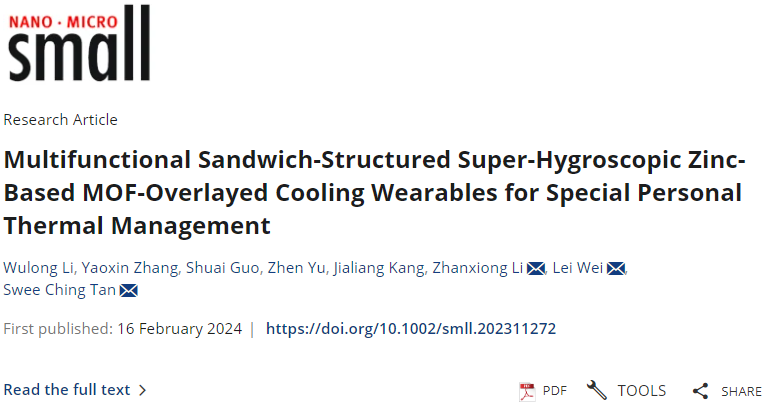
Recently, in this context, Professor Zhanxiong Li's research group from the School of Textile and Clothing Engineering at Soochow University, Professor Lei Wei's research group from the School of Electrical and Electronic Engineering at Nanyang Technological University in Singapore, and Professor Tan Swee Ching's research group from the School of Materials Science and Engineering at the National University of Singapore have proposed a new concept that integrates super absorbent, antibacterial, and anti fouling properties into a wearable refrigeration garment to achieve long-term personal thermal management. Specifically, a sandwich like structure consisting of a calcium doped poly (4-styrenesulfonic acid) sodium membrane (Ca PSS) with super hygroscopicity and a superhydrophobic Zn based MOF fabric was designed to achieve cooling, anti fouling, and antibacterial capabilities during human sweating in high-temperature environments.
Ca PSS membrane can quickly absorb sweat produced on human skin, effectively reducing humidity and temperature heat index in the human microenvironment, thereby exhibiting good cooling effect, preventing dehydration and heatstroke, and improving the thermal comfort of the internal microenvironment of protective clothing.
It is worth noting that the sandwich structure of Ca PSS film/MOF wearable fabric has the Janus characteristic of unidirectional moisture conductivity, which allows sweat water vapor to pass through the fabric unidirectionally and remain in the network of Ca PSS film inside. This can prevent absorbed sweat from flowing back to the surface of the skin. In addition, superhydrophobic MOF fabrics not only exhibit excellent anti fouling and antibacterial properties, but also further prevent secondary discomfort caused by direct contact of sweat absorbing membranes with the skin.
Therefore, the multifunctional sandwich structured super absorbent Ca PSS/MOF wearable device can help those who need to wear protective clothing to work in high temperature environments (firefighters, soldiers, medical staff, etc. around the world), significantly reduce the humidity and heat index in the internal microenvironment of their protective clothing, and achieve cooling comfort. Finally, simulation experiments were conducted on T-shirts and firefighting suits prepared by human wearing, which proved that the prepared T-shirts can alleviate thermal stress on the human body through efficient sweating and evaporative cooling, improve comfort, and have excellent antibacterial and anti fouling properties.
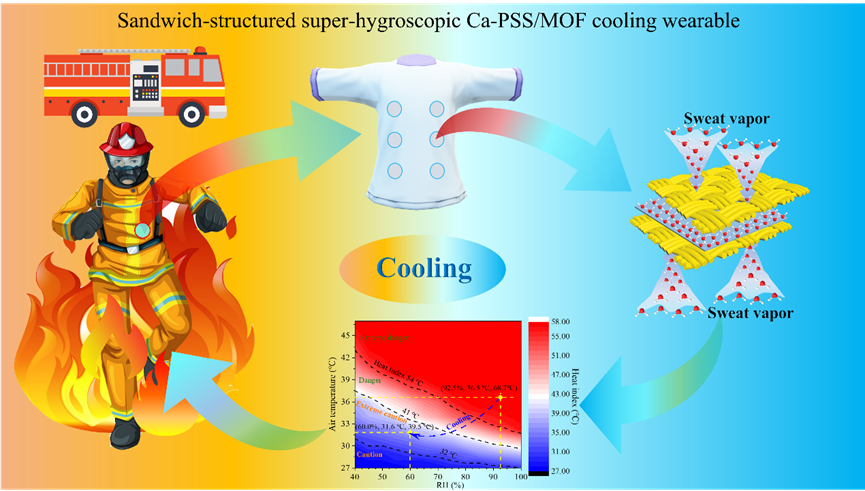
Figure 1 Schematic diagram of the application of multifunctional sandwich structure super absorbent Zn based MOF refrigeration wearable clothing
Key points of this article:
(1) The author proposes a new concept of integrating Ca PSS/MOF moisture absorbing refrigeration for wearable clothing for human thermal management. The device features a multifunctional "sandwich" structure design and combines the advantages of MOF T-shirts and super absorbent Ca PSS membranes.
(2) The designed sandwich like structure can unidirectionally transport sweat moisture from the protective suit microenvironment to the inner layer of the Ca PSS membrane, while preventing absorbed sweat from transferring back to the body surface and remaining in the network of the Ca PSS membrane, thereby enhancing the cooling effect of Ca PSS/MOF refrigeration wearable.
(3) The prepared Ca PSS film has the characteristics of high water absorption, excellent reusability, energy-saving regeneration, and on-demand adjustability. In addition, MOF wearable fabrics have excellent self-cleaning and antibacterial properties, which can effectively prevent pollutant pollution, kill and inhibit the growth of bacteria or fungi in human protective clothing, and provide a healthy and comfortable microenvironment for the human body.
(4) Most notably, compared to regular T-shirts, this type of Ca PSS/MOF moisture absorbing refrigeration suit with a "sandwich" structure can significantly reduce the relative humidity and temperature inside firefighters' protective clothing, from 91.0% to 60.0% and from 36.5 ℃ to 31.6 ℃, respectively, thereby reducing the thermal index from 65.0 ℃ to 39.5 ℃ and significantly improving human comfort. Reduce the risk of heatstroke and heat related illnesses.
(5) This type of wearable moisture absorbing refrigeration device can be widely used by firefighters around the world, and can also be extended to other professions facing severe thermal discomfort and stress, such as healthcare workers, soldiers, and construction workers.
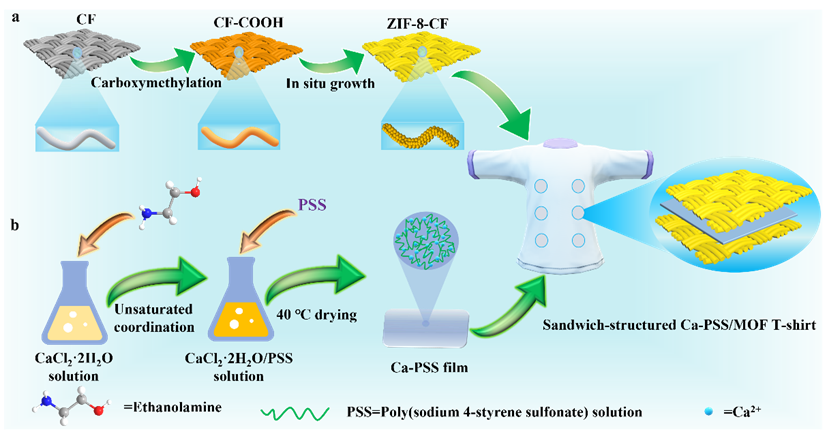
Figure 2: Schematic diagram of the preparation process of Ca PSS/MOF moisture absorbing refrigeration clothing with a sandwich structure. a) The preparation process of ZIF-8-CF and b) super absorbent Ca PSS film.
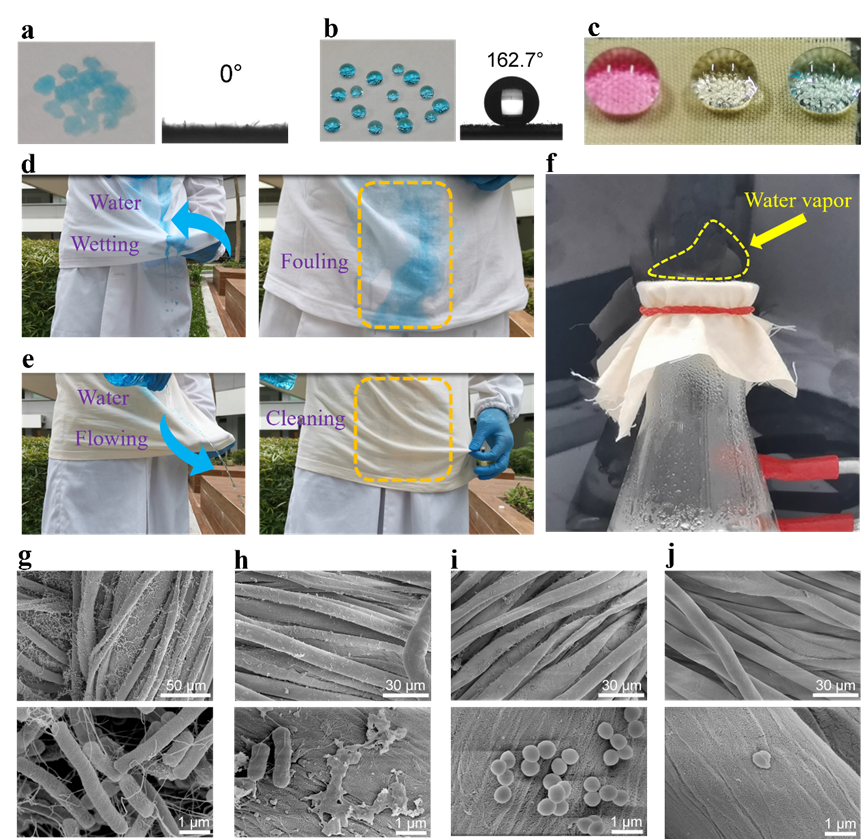
Figure 3 Wettability and antibacterial properties of superhydrophobic ZIF-8-CF fabric. a) CF and b) Photos of water droplets on the superhydrophobic ZIF-8-CF surface and WCA. c) The state diagram of droplets on the superhydrophobic ZIF-8-CF surface at different pH values (pH values from left to right are 2, 7, and 13, respectively). d) Anti fouling test of ordinary T-shirts and e) superhydrophobic ZIF-8-CF T-shirts. f) Water vapor permeability test of superhydrophobic ZIF-8-CF. SEM images of the presence of Escherichia coli and Staphylococcus aureus on the surfaces of CF and superhydrophobic ZIF-8-CF.

Figure 4: Sweat Capture Performance of Ca PSS Membrane. a) Schematic diagram of moisture absorption and desorption process of Ca PSS membrane. b) The water vapor adsorption curves of PSS, CaCl2, ethanolamine, Ca complex, and Ca PSS membrane at 24.0 ℃ and 72% RH for 60 minutes. c) Moisture absorption isotherms of Ca PSS membrane under different relative humidity conditions (35.0 ℃). d) Desorption isotherms of Ca PSS membrane at different temperatures. e) Number of cycles of moisture absorption/desorption. f) RH curves in the measured space using Ca PSS membrane, CaCl2, and silica gel as desiccants. Infrared images and photos of the left hand placed in the container for g) 0 minutes and i) 5 minutes without using Ca PSS moisture absorbing film. Infrared images and photos of the right hand in the container at h) 0 minutes and j) 5 minutes in the presence of Ca PSS moisture absorbing film.
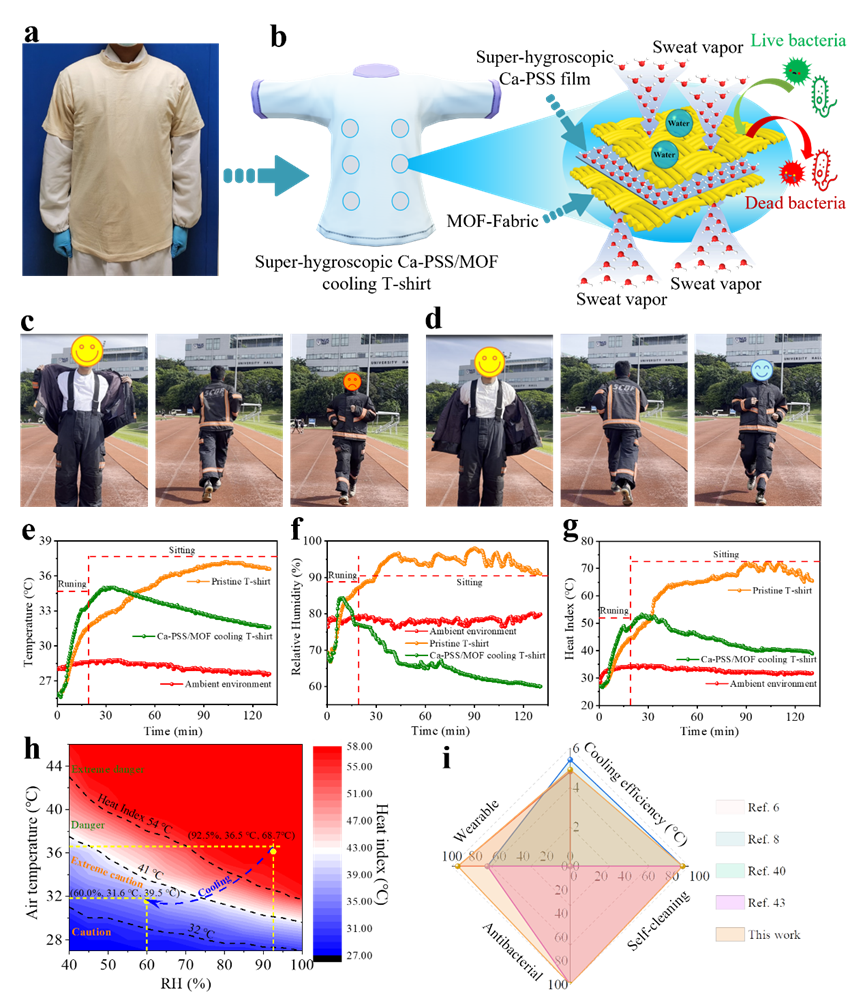
Figure 5 shows the moisture absorption and cooling performance of Ca PSS/MOF wearable clothing with a sandwich structure. a) Model wearing ZIF-8@T A photo of the shirt. b) Schematic diagram of Ca PSS/MOF wearable clothing with a sandwich like structure. Firefighters wear c) regular T-shirts or d) Ca PSS/MOF refrigerated T-shirts for transportation testing. Firefighters wearing regular T-shirts or Ca PSS/MOF cooling T-shirts show the temperature, relative humidity, and thermal index data inside their protective clothing during running and sitting. h) Heat index cloud map. i) Radar chart comparing the performance with other functional textiles.
Summary and outlook:
In summary, the author has developed a multifunctional "sandwich" structure Ca PSS/MOF moisture absorbing and cooling wearable garment for human thermal management in special situations. Ca PSS/MOF moisture absorbing refrigeration clothing integrates the advantages of MOF fabric and super absorbent Ca PSS membrane, while also possessing features such as anti fouling, antibacterial, moisture absorbing, and easy processing. The new Ca PSS/MOF moisture absorbing and cooling wearable sandwich structure achieves unidirectional sweat and moisture transport from the protective clothing microenvironment to the inner layer of the Ca PSS membrane. On the contrary, the transport of sweat to the outside of wearable devices is limited, and it is retained in the network of Ca PSS membrane, preventing the absorbed sweat from transferring back to the skin surface and affecting the cooling effect of Ca PSS/MOF clothing. The Ca PSS membrane prepared has the characteristics of high moisture absorption capacity, excellent reusability, energy saving and renewable, and controllability. In addition, MOF wearable devices have excellent self-cleaning and antibacterial properties, which can effectively prevent pollutant pollution, inhibit the growth of bacteria or fungi in workers' protective clothing, and provide a healthy and comfortable microenvironment for the human body. Compared with ordinary fabrics, Ca PSS/MOF refrigeration suits can significantly reduce the relative humidity and temperature inside firefighter protective suits from 91.0% and 36.5 ℃ to 60.0% and 31.6 ℃, respectively, thereby reducing the thermal index from 65.0 ℃ to 39.5 ℃. The practical application results show that the super absorbent Ca PSS/MOF fabric can significantly reduce the possibility of heatstroke in the human body, reducing the corresponding hazard index from "extremely dangerous" to "extremely cautious", and the refrigeration effect is obvious. This type of wearable moisture absorbing refrigeration device can be widely used by firefighters around the world, and can also be extended to other professions that require long-term exposure to hot environments and face severe heat discomfort and stress, such as medical staff, soldiers, and construction workers. Therefore, we hope that this multifunctional super absorbent Ca PSS/MOF refrigeration wearable device with a sandwich like structure can provide a new path for the development of personal thermal management.
This achievement was recently published in Small, and the first author of the article is Dr. Li Wulong from the School of Textile and Clothing Engineering at Soochow University (currently a postdoctoral fellow at Nanyang Technological University in Singapore). This work has received support from the National Natural Science Foundation of China (No. 51673137), the Jiangsu Graduate Research and Practice Innovation Program (No. KYCX20-2665), the China Scholarship Council (CSC, 202106920042), key academic projects of higher education institutions in Jiangsu Province, as well as academic research funds from the Singapore Ministry of Education (MOE-T2-A-0005415-01-00, MOE2019-T2-127, MOE-T2EP50120-0002).
Fabric Category
Latest News
CONTACT US
Phone: +86 13967890005
Email: sales@neocamo.com
Add: Room 1009, No. 562 West Jinshan Road, Yinzhou District, Ningbo City, Zhejiang Province, China
 Skype
Skype